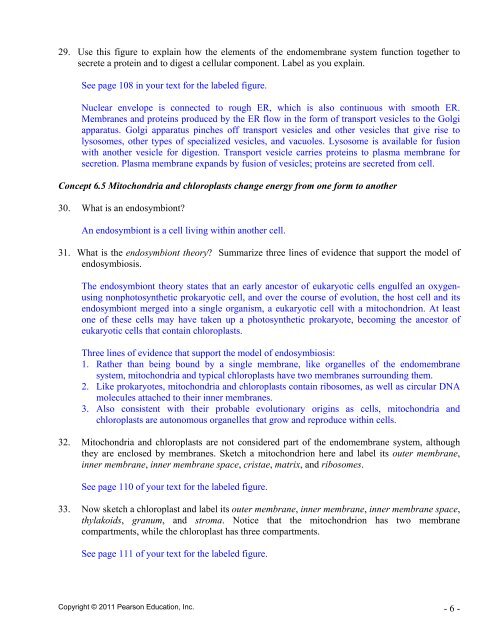You also want an ePaper? Increase the reach of your titles
YUMPU automatically turns print PDFs into web optimized ePapers that Google loves.
29. Use this figure to explain how the elements of the endomembrane system function together to<br />
secrete a protein and to digest a cellular component. Label as you explain.<br />
See page 108 in your text for the labeled figure.<br />
Nuclear envelope is connected to rough ER, which is also continuous with smooth ER.<br />
Membranes and proteins produced by the ER flow in the form of transport vesicles to the Golgi<br />
apparatus. Golgi apparatus pinches off transport vesicles and other vesicles that give rise to<br />
lysosomes, other types of specialized vesicles, and vacuoles. Lysosome is available for fusion<br />
with another vesicle for digestion. Transport vesicle carries proteins to plasma membrane for<br />
secretion. Plasma membrane expands by fusion of vesicles; proteins are secreted from cell.<br />
Concept 6.5 Mitochondria and chloroplasts change energy from one form to another<br />
30. What is an endosymbiont?<br />
An endosymbiont is a cell living within another cell.<br />
31. What is the endosymbiont theory? Summarize three lines of evidence that support the model of<br />
endosymbiosis.<br />
The endosymbiont theory states that an early ancestor of eukaryotic cells engulfed an oxygenusing<br />
nonphotosynthetic prokaryotic cell, and over the course of evolution, the host cell and its<br />
endosymbiont merged into a single organism, a eukaryotic cell with a mitochondrion. At least<br />
one of these cells may have taken up a photosynthetic prokaryote, becoming the ancestor of<br />
eukaryotic cells that contain chloroplasts.<br />
Three lines of evidence that support the model of endosymbiosis:<br />
1. Rather than being bound by a single membrane, like organelles of the endomembrane<br />
system, mitochondria and typical chloroplasts have two membranes surrounding them.<br />
2. Like prokaryotes, mitochondria and chloroplasts contain ribosomes, as well as circular DNA<br />
molecules attached to their inner membranes.<br />
3. Also consistent with their probable evolutionary origins as cells, mitochondria and<br />
chloroplasts are autonomous organelles that grow and reproduce within cells.<br />
32. Mitochondria and chloroplasts are not considered part of the endomembrane system, although<br />
they are enclosed by membranes. Sketch a mitochondrion here and label its outer membrane,<br />
inner membrane, inner membrane space, cristae, matrix, and ribosomes.<br />
See page 110 of your text for the labeled figure.<br />
33. Now sketch a chloroplast and label its outer membrane, inner membrane, inner membrane space,<br />
thylakoids, granum, and stroma. Notice that the mitochondrion has two membrane<br />
compartments, while the chloroplast has three compartments.<br />
See page 111 of your text for the labeled figure.<br />
Copyright © 2011 Pearson Education, Inc. - 6 -


